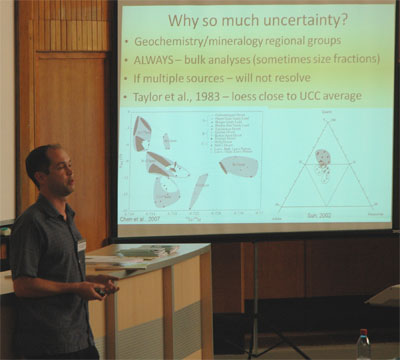LOESSFEST'09 | Aug. 31st – Sept. 3rd, 2009 |Novi Sad-Serbia
Assessing the Sources of Loess Using Single-Grains
Thomas Stevens1
1Royal Holloway, University of London, Egham Hill, EGHAM, TW20 0EX, UK
The sources of loess have long been the subject of considerable debate in many areas around the world. Even with the advent of advanced geochemical techniques, data are often ambiguous, difficult to interpret and lead to contrasting interpretations. This uncertainty limits interpretation of the mechanisms responsible for its emplacement, and consequently prevents proper interpretation of loess as a sedimentary/environmental archive.
 It could be argued that part of the difficulty has been due to the overwhelming
use of multiple-grains (i.e. bulk sample) geochemistry. Due to the necessary
averaging of potentially diagnostic information from individual grains, such analyses
are unlikely to resolve source regions if multiple areas are involved, as in
many cases seems likely. By contrast, geochemical analysis of single-grains circumvents
these issues as each grain will contain unique information that is potentially
diagnostic of an individual source.
It could be argued that part of the difficulty has been due to the overwhelming
use of multiple-grains (i.e. bulk sample) geochemistry. Due to the necessary
averaging of potentially diagnostic information from individual grains, such analyses
are unlikely to resolve source regions if multiple areas are involved, as in
many cases seems likely. By contrast, geochemical analysis of single-grains circumvents
these issues as each grain will contain unique information that is potentially
diagnostic of an individual source.
Here, the potential use of single-grains in loess provenance studies is outlined
through initial work in China. The morphology and the first LA-ICP-MS U-Pb
ages of detrital zircons from last glacial age loess on the northern Loess Plateau
are compared to zircon U-Pb age spectra from deserts, crustal blocks and orogenic
belts surrounding the Loess Plateau. The results demonstrate that the loess zircon
U-Pb age spectrum shows no single affinity to any single region and exhibits
characteristics associated with granitoid rocks in both west and east northern
China. Furthermore, and in contrast to proximal deserts, a significant proportion
of zircons from the loess show affinities with rocks cropping out in the Qilian
Mountains. The euhedral form of many of these grains further suggests direct
transport from these crystalline source rocks, in contrast to previously hypothesized
production in deserts. The implications of these findings for understanding
past climate are briefly explored.



